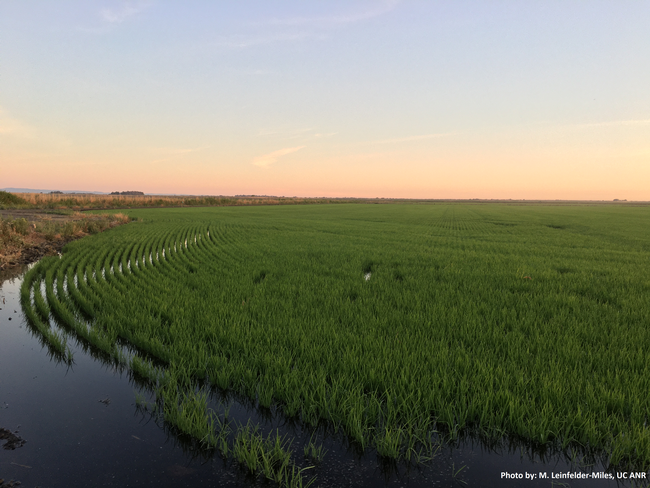In 2021, rice acreage in the Delta, south of the Yolo Bypass, was roughly 6,600 acres. Most of the Delta acreage is in San Joaquin County, with a few hundred acres in Sacramento County. Delta rice acreage has been steadily increasing over the last several years (Table 1). Most of the acreage was planted with variety M-206, but I have heard that a small amount of M-105 was also planted.
Table 1. Rice acreage and yield according to the San Joaquin County Agricultural Commissioner's crop reports. County rice production is predominantly (if not entirely) in the Delta region. The 2021 acreage estimate includes a few hundred acres in the Sacramento County Delta.

Pest pressure was not especially high across the region in 2021, but I consulted with growers and consultants on a handful of pests. Watergrass, barnyardgrass, and sprangletop can be problematic weeds. These are generally controlled by a spray program applied by ground pre-flood, when the rice has 3-4 leaves. Windy conditions can compromise optimal timing for herbicide applications, and this year was no exception. Typically, a second application is not made, but some growers contemplated it this year for escaped grasses. Over the last two years, I have conducted trials to evaluate the efficacy of a new product, Loyant (florpyrauxifen-benzyl; Corteva Agriscience), on these grasses in the Delta drill-seeded system. This year, we evaluated product efficacy on nutsedge, and those results will be forthcoming.
I have been trapping armyworms in the Delta since 2016, and like in the Sacramento Valley, armyworm populations were very low this year. Some growers indicated needing to treat some of their acreage, particularly where rice was neighbored by riparian or wetland vegetation, but other growers did not treat. Annual trap counts for the Delta are available on my website.
Last year, we started observing stem rot (Sclerotium oryzae) on some farms but not until late in the season when the fields were drained. We developed post-harvest straw management programs, which appear to have mitigated the problem but not eliminated it. Next year, we will monitor for the disease early in the year, and a fungicide application may be necessary on some farms. There is a tendency for stem rot to be more severe on low potassium soils, and most Delta soils are naturally low in potassium.
For a few years, we have been monitoring some ranches where we have identified weedy rice. On one farm that had a light infestation, it appears that the grower has eliminated weedy rice with in-season rogueing, post-harvest management that included straw chopping but no incorporation, and winter flooding. These appear to be important practices, especially with light infestations, and in particular until a herbicide is approved for spot-spraying. We also advise that growers pay attention to equipment sanitation – harvesting weedy rice fields last (if possible) and thoroughly cleaning out equipment after harvesting fields with weedy rice.
Cooler temperatures in the Delta, compared to the Sacramento Valley, make the Delta a challenging place to grow rice. Growers are limited to using only very-early and early maturing varieties. In 2021, we revived the UCCE variety trial in the Delta location, which will help in the identification and advancement of cold-tolerant varieties. Low night time temperatures can cause blanking, which results in empty grains. We expect blanking to occur when the developing pollen grains are exposed to nighttime temperatures at or below 55 degrees F for several hours. I am aware of a late-planted ranch that may have experienced some blanking due to cooler temperatures at the time of panicle development, but blanking should not be a problem for the majority of fields that were planted by mid-April.
Overall, 2021 was a successful year for Delta rice growers. Thank you to all my colleagues in the industry, and especially to my trial cooperators.
